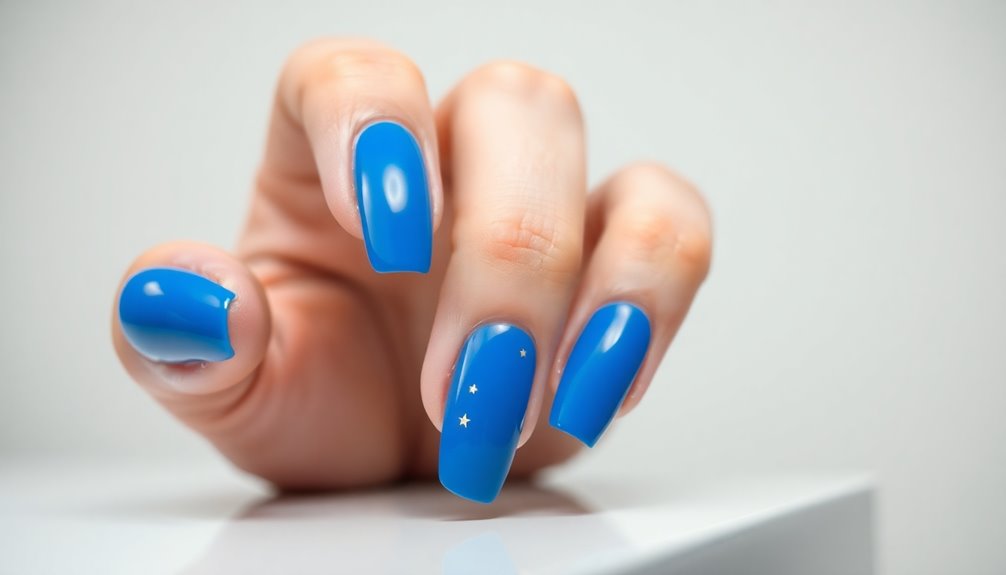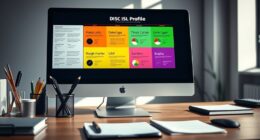To nail your "Tell me about yourself" introduction, start with brevity. Craft a structured response using the present, past, and future format. Highlight your key accomplishments with quantifiable achievements to grab attention. Don't forget to personalize your approach based on your audience. Adding a touch of personality or a light-hearted joke can create connection and make you memorable. Practice your delivery to guarantee confidence and clarity. Finally, avoid common mistakes like rambling or sounding too rehearsed. There's a lot more you can explore to make your intro truly mind-blowing!
Key Takeaways
- Start with a concise introduction that outlines your current role, expertise, and what makes you unique.
- Use the present, past, future format to structure your response effectively.
- Highlight key accomplishments with quantifiable data to demonstrate your impact.
- Tailor your message to the audience's interests and values for better engagement.
- Conclude with a strong statement that reinforces your key skills and future aspirations.
Keep It Brief

When introducing yourself, aim to keep it brief—ideally, your introduction should be no longer than a few sentences. You want to respect others' time and maintain their interest, so avoid rambling or oversharing. Instead, focus on key points that are relevant to the context. Think about what you'd want to know if you were in the audience.
Refrain from sharing your entire autobiography. Stick to professional and relevant information that highlights your strengths. This way, you won't overwhelm your audience with unnecessary personal details. Keeping it concise helps maintain engagement and leaves room for improvisation, making your introduction feel more natural.
Be mindful of the time allocated for introductions. Prepare your intro beforehand to avoid awkward pauses or abrupt thinking. A clear and immediate introduction sets the right tone, ensuring you come across as confident and composed. Keeping your introduction concise can also foster better connections with those listening.
Rather than repeating your resume, sprinkle in relevant examples that showcase your skills and experiences. This approach not only keeps it brief but also makes your introduction memorable. Remember, less is often more, so keep it straightforward and engaging.
Customize Your Approach

Customizing your approach is essential for making a lasting impression during introductions. Tailoring your message to the specific context isn't just smart; it's necessary. If you're in a job interview, focus on your professional experience, skills, and qualifications relevant to the position. In a business setting, highlight your achievements and industry experience. For social settings, share your hobbies and community involvement to connect personally. In an academic context, emphasize your educational background and relevant courses. Additionally, consider the importance of establishing a bedtime routine if your introduction is within a parenting context, as it shows awareness of balancing personal and professional life.
Understanding your audience is key. Adapt your communication style to match their preferences and personalities. Share details that resonate with them while avoiding irrelevant information. This helps build a genuine connection. Show enthusiasm for the context or industry; it'll make your introduction memorable. Incorporating a well-structured response can significantly enhance your interview performance.
Highlighting key aspects of your background matters too. Emphasize significant roles, responsibilities, and achievements. Mention relevant skills and certifications while sprinkling in personal interests that add a unique touch. For instance, discussing your role in supporting a partner during postpartum recovery can highlight your adaptability in personal situations.
Make sure to articulate your career aspirations, especially how they align with the opportunity at hand. Ultimately, a well-customized approach not only engages your audience but also sets you apart from the rest.
Use a Structured Framework

A structured framework can considerably enhance your introductions, making them more effective and memorable. By following a consistent format, you guarantee clarity and coherence, allowing your audience to grasp your key points quickly.
Start by reviewing the context of your introduction. Know the audience and what they value, just like you'd analyze a job description to highlight relevant skills.
Next, outline the main points you want to cover. Think of this as creating a list of hard and soft skills that align with your message. A well-structured introduction mirrors the importance of structured interview formats in ensuring clarity and fairness.
Begin with a strong opening statement, followed by specific examples that illustrate your main points. Just like in an interview, where a standardized set of questions helps maintain focus, your structured approach keeps your introduction streamlined.
As you deliver your introduction, stick to the predetermined order of your points. This method helps maintain flow and keeps your audience engaged.
Finally, leave them with a strong closing statement that reinforces your key message. By using a structured framework, you not only enhance your introduction's impact but also make it easier for your audience to remember what you've shared.
Highlight Key Accomplishments

When you highlight your key accomplishments, start with a clear overview of your current role and what makes you stand out.
Don't forget to showcase notable past achievements that demonstrate your impact and unique skills. This approach not only grabs attention but also sets the stage for a compelling narrative about your professional journey. Additionally, incorporating quantifiable data can further enhance the significance of your accomplishments and provide clear evidence of your contributions.
Current Role Overview
In the domain of financial management, your expertise shines through impressive accomplishments that drive organizational success.
You've managed a financial team overseeing project budgets exceeding $400,000, ensuring that every dollar is effectively allocated. By modernizing financial reporting processes, you reduced redundancies by 23% and lowered labor input by 12%, streamlining operations considerably.
Your implementation of cost-saving initiatives and productivity tools, including efficient internal audit procedures and SAP ERP software, has transformed the company's financial landscape. A focus on budget management allows for more strategic allocation of resources.
You've skillfully analyzed overtime expenditures, achieving a remarkable 33% in cost savings. Additionally, your proactive approach in addressing delinquent accounts led to a 12% reduction in bad debt, showcasing your ability to enhance cash flow. This consistent tracking of accomplishments fosters a sense of empowerment and readiness in your role.
Through these strategic initiatives, you've not only improved efficiency but also solidified your role as a key player in financial management.
Your commitment to excellence and results-oriented mindset continue to propel the organization towards greater financial health and operational efficiency.
These accomplishments illustrate your capability to drive impactful change, making you an invaluable asset in your current role.
Notable Past Achievements
Throughout your career, you've amassed a series of notable achievements that showcase your leadership and innovation in various domains.
You've successfully managed a team of 20 employees, achieving a 30% increase in productivity while reducing turnover by 20%. Your ability to lead cross-functional teams resulted in delivering complex projects ahead of schedule and under budget, saving $500,000.
In customer service, you resolved complaints with a remarkable 98% satisfaction rate and implemented a response program that cut response times by 20%, boosting client retention by 22%. Resume accomplishments are crucial in highlighting your effectiveness, as they provide tangible proof of your contributions.
You've also increased customer engagement by 30% through targeted initiatives and revitalized outreach programs.
Your project management skills shone while managing deep sewer and water pipeline projects valued at up to $100M, yielding a 20% profit margin.
You integrated new systems that reduced downtime by 18% and delivered critical IT initiatives under budget.
Additionally, you've implemented innovative processes that slashed production costs by 20% and identified tax savings that reduced overall liabilities by 15%.
These accomplishments underline your effectiveness in driving results and fostering positive change within organizations.
Unique Skills Showcase
Identifying your unique skills is essential for showcasing your strengths effectively. Reflect on your past experiences and achievements to pinpoint the skills you consistently use. You might find it helpful to seek feedback from colleagues or mentors; they can provide valuable insights into your strengths. Gathering feedback can significantly enhance your understanding of how others perceive your abilities. Additionally, focusing on content quality can help you articulate your skills more effectively.
Align these skills with the job description to identify which ones are most relevant for the position you're pursuing.
When crafting your response, highlight key skills that directly address the job requirements. For instance, if communication is vital, you could say, "One of my key strengths is my ability to communicate effectively across teams." Emphasize soft skills like leadership and problem-solving, showing how they can tackle the company's specific challenges.
Make sure to practice your delivery through mock interviews. Use the STAR method to structure your responses, ensuring clarity and impact. By recording and reviewing your answers, you can refine your style for maximum effectiveness.
Finally, don't forget to summarize your unique skills at the end of the interview. This leaves a lasting impression and reinforces your fit for the role.
Add Personality and Humor

Adding personality and humor to your intro can really make you stand out. Share a personal anecdote or a unique hobby that reflects your values, and don't shy away from a lighthearted joke to break the ice. Just remember, keep it relevant and professional to guarantee it resonates with your audience. Additionally, incorporating preparation and planning into your introduction can enhance your credibility and engagement with the interviewer.
Incorporate Personal Anecdotes
Incorporating personal anecdotes can really make your introduction stand out and resonate with your audience. When you share relevant hobbies, like your passion for community gardening, you not only reveal your interests but also showcase skills like teamwork and problem-solving.
Maybe you've turned a vacant lot into a lush garden with neighbors, highlighting your ability to collaborate for a common goal. You could also mention experiences that demonstrate your customer service skills. Perhaps you recall a time when a frustrated client walked into your previous job, and you turned their day around by listening and empathizing. By quantifying the impact—maybe you increased customer satisfaction ratings by 20%—you add credibility to your story.
Connecting these personal experiences to the job you're applying for can make a significant impression. For instance, if you're pursuing a role in education, discussing your volunteer work at a local tutoring center shows your commitment to helping others and aligns with the company's values. Additionally, sharing your ability to articulate your strengths concisely can reflect your communication skills.
Keep your anecdotes brief and professional, ensuring they highlight your strengths while keeping your audience engaged. This personal touch can be the key to leaving a lasting impression.
Use Lighthearted Jokes
Lighthearted jokes can be a powerful tool to inject personality and humor into your introductions. When asked about your productivity, a witty response like, "I'm most productive when the boss is watching," can break the ice and create a relaxed atmosphere.
Humor can also highlight your strengths; saying, "I can fold under pressure" while referencing your origami skills showcases your creativity. Just like the scarecrow who got a job because he was outstanding in his field, you can demonstrate your unique qualities.
Addressing weaknesses lightly can work wonders too. Instead of saying, "I'm terrible at interviews," try something like, "My biggest weakness is my listening skills." This approach not only elicits a chuckle but also shows you can laugh at yourself.
When discussing salary expectations, a line like, "Competitive salary means my salary will be competing against my bills," keeps the conversation light.
Puns and wordplay can add an extra layer of charm. For instance, "Why did the scarecrow get the job? He was outstanding in his field" can make you memorable.
Share Unique Hobbies
Unique hobbies can be a fantastic way to showcase your personality and add a touch of humor to your introductions. Instead of the usual "I enjoy reading," why not spice things up? Share a quirky hobby that'll leave your audience curious and entertained.
Here's a table to inspire you:
| Creative Hobbies | Unique Hobbies |
|---|---|
| Painting | Extreme Ironing |
| Pottery | Underwater Pumpkin Carving |
| Drawing | Worm Charming |
| Graphic Design | Shin-Kicking |
Imagine introducing yourself as an underwater pumpkin carver! You'll definitely stand out. Or maybe you're a candle maker who loves to make candles shaped like famous landmarks—now that's a conversation starter! Including unique hobbies on your resume can not only reflect your personality but also differentiate you in a competitive job market.
Adding a lighthearted touch, like mentioning extreme ironing while dangling off a cliff, can elicit a chuckle and make you memorable. So, when you’re asked, “Tell me about yourself,” don’t hesitate to share your unique hobbies. They reveal your character and can spark engaging conversations, making it easier to connect with others. Crafting the perfect introduction means not just listing off your job title and qualifications, but also sharing what makes you truly unique. Whether it’s extreme ironing, collecting vintage soda bottles, or knitting sweaters for your pet iguana, these hobbies can set you apart and show off your personality. Embracing these quirks and passions can help you make a lasting impression and create meaningful connections with those around you.
Practice for Perfection

Practicing for perfection is essential when preparing for an interview. Start by thoroughly researching the company's mission, values, and culture. Review the job description to grasp the responsibilities and qualifications, and anticipate questions by looking over your CV or application. Use the STAR method to prepare examples from your past experiences, ensuring you can highlight relevant skills effectively. Engaging in online communities can provide additional insights and support during your preparation process.
Next, practice answering common interview questions aloud, preferably with a friend. Focus on being direct and succinct while showcasing your experience. The STAR method is invaluable for structuring your responses to behavioral questions, helping you articulate your thoughts clearly. Additionally, demonstrating genuine interest in the organization can set you apart from other candidates.
Don't shy away from addressing weaknesses or gaps in your experience; instead, prepare thoughtful explanations that align with the company's expectations.
Customize your introduction to make it brief yet impactful. Use a three-point framework: present your current role, discuss relevant past experiences, and express enthusiasm for future opportunities.
Rehearse your delivery to avoid rambling, maintaining good posture and eye contact. With careful preparation and practice, you'll not only nail your intro but also leave a lasting impression that demonstrates you're the right fit for the role.
Engage Your Audience

Nailing your introduction sets the stage, but engaging your audience takes your interview to the next level. To truly connect, you need to understand and personalize your content. Conduct surveys and gather feedback to pinpoint what resonates with your audience. Analyze social media data to tailor your message, ensuring it reflects their interests and values. Additionally, incorporating analytics insights can help you identify which topics and formats engage your audience the most.
Incorporate interactive and visual elements to keep them captivated. Use eye-catching visuals, videos, or infographics, and consider hosting live streams or Q&A sessions that invite real-time interaction. Gamification techniques like quizzes and polls can add an element of fun that keeps your audience on their toes. Engaged audiences not only enhance brand reputation but also share positive experiences that can amplify your reach.
Fostering a community is equally important. Engage with your audience on social media and respond to their comments and messages promptly. Encourage them to share user-generated content, making them feel valued and connected. Understanding your audience's preferences can also guide your content planning, ensuring it remains relevant and engaging.
Lastly, maintain consistency and authenticity in your interactions. Post regularly and stay true to your brand's values. Match your tone to the setting, and offer incentives like giveaways to keep enthusiasm high. Regular content creation is key to building a loyal community that looks forward to your contributions.
With these strategies, you'll not only capture attention but also build long-lasting connections.
Common Mistakes to Avoid

When it comes to interviews, steering clear of common mistakes can make all the difference in your success. One major pitfall is using a canned response that doesn't address the employer's needs. Tailor your introduction to highlight experiences and skills relevant to the job description. Avoid starting with a generic career path summary; instead, focus on accomplishments that relate to the position.
Another mistake is sharing irrelevant or personal information. Leave out details like your age or marital status and steer clear of hobbies that don't connect to the job. Discussing controversial topics can also be a red flag, so keep it professional. Maintain professionalism by keeping personal anecdotes minimal and ensuring all shared information serves a purpose in the interview.
Additionally, rambling or lacking structure can undermine your message. Keep your response under three minutes and practice it to guarantee clarity. Follow a structured approach, like the present, past, future format, and make sure to summarize effectively.
Finally, don't repeat your resume verbatim. Instead, connect your past experiences to the role at hand, emphasizing unique strengths that set you apart. Use storytelling to engage your audience and express enthusiasm for the opportunity.
Frequently Asked Questions
How Do I Handle Nervousness During Introductions?
When you're handling nervousness during introductions, remind yourself that it's completely normal. Accept those jitters and use deep breathing to calm your nerves.
Focus on your message instead of your anxiety. Practice in front of a mirror or friends to build confidence. Visualize yourself succeeding, and use positive self-talk to boost your mindset.
When you enter the room, walk in confidently, smile, and make eye contact to engage your audience.
What if I Can't Think of a Unique Fact About Myself?
What if you can't think of a unique fact about yourself? Don't worry; you're not alone.
Start by reflecting on your childhood dreams or quirky hobbies. Maybe you've got a hidden talent, like juggling or a knack for storytelling.
Consider memorable experiences or travel adventures that shaped you. As you dig deeper, you might uncover fascinating aspects of your life that'll not only surprise you but also captivate those listening.
Should I Memorize My Introduction Word-For-Word?
You shouldn't memorize your introduction word-for-word. Doing so can make you sound robotic and unengaged.
Instead, focus on key talking points that highlight your education, experience, and skills relevant to the job. This way, you'll sound natural and conversational.
Practicing with a mental outline will help you stay confident and ready for unexpected questions.
How Do I Adapt My Intro for Different Cultures?
To adapt your introduction for different cultures, start by researching their customs.
Pay attention to personal space; some cultures prefer distance, while others embrace closeness. Adjust your greeting style accordingly—use a handshake in the U.S. or a bow in Japan.
Remember that eye contact varies; maintain it in some cultures, but avoid it in others. Always be observant, and if you're unsure, it's okay to ask for guidance on appropriate practices.
Can I Use Visuals or Props During My Introduction?
Absolutely, you can use visuals or props during your introduction! They help capture attention and make your message more memorable.
Just guarantee your props are relevant and visible to the audience. Introduce them slowly to build anticipation, and use them to highlight key points.
Engaging your audience with interactive elements or storytelling will make your introduction even more impactful.
Remember to practice integrating your props smoothly into your speech for the best effect!
Conclusion
Nailing your "tell me about yourself" intro can be like hitting the bullseye in archery—it takes practice and precision. By keeping it brief, customizing your approach, and showcasing your key accomplishments, you'll leave a lasting impression. Don't forget to sprinkle in a bit of personality and humor to connect with your audience. With a little practice, you'll be ready to engage and impress, making your introduction not just memorable, but truly enchanting.
Emmeline is the backbone of our content creation team, bringing complex psychological concepts to life with clarity and empathy. As our Expert Writer, she crafts engaging, insightful articles that guide readers through the intricacies of personality assessments and what they reveal about the human condition. Her passion for psychology and personal development shines through in every piece she writes.










